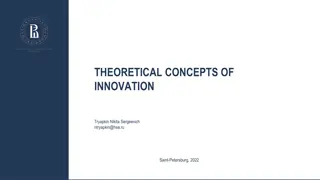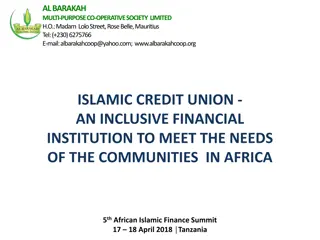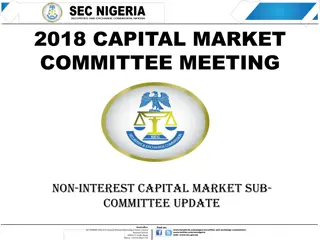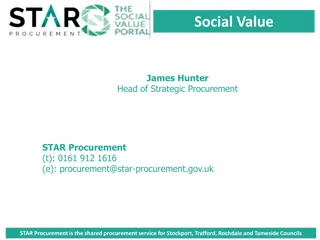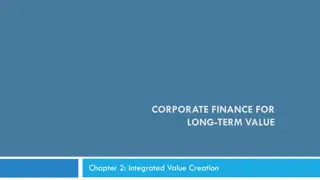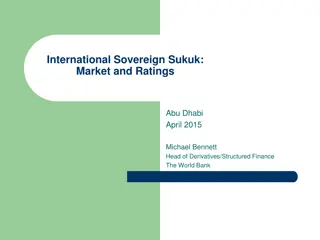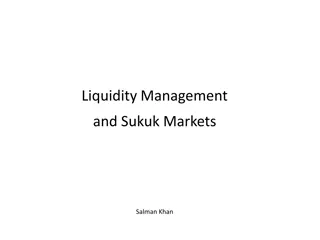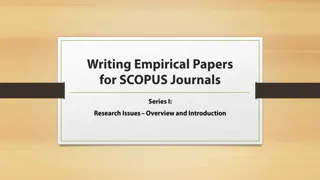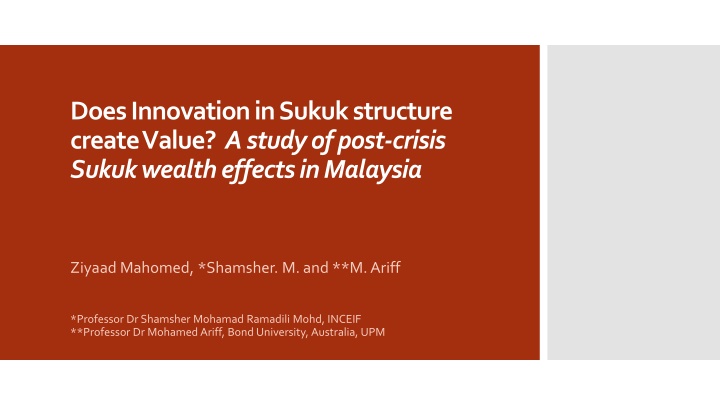
Innovation in Sukuk Structure: Creating Value in Post-Crisis Malaysia
This study examines the impact of Sukuk innovation on firm value in the Malaysian market post-crisis, investigating the wealth effects of innovative Sukuk structures and their implications for capital structure theory and market perception.
Download Presentation

Please find below an Image/Link to download the presentation.
The content on the website is provided AS IS for your information and personal use only. It may not be sold, licensed, or shared on other websites without obtaining consent from the author. If you encounter any issues during the download, it is possible that the publisher has removed the file from their server.
You are allowed to download the files provided on this website for personal or commercial use, subject to the condition that they are used lawfully. All files are the property of their respective owners.
The content on the website is provided AS IS for your information and personal use only. It may not be sold, licensed, or shared on other websites without obtaining consent from the author.
E N D
Presentation Transcript
Does Innovation in Sukuk structure create Value? A study of post-crisis Sukuk wealth effects in Malaysia Ziyaad Mahomed, *Shamsher. M. and **M. Ariff *Professor Dr Shamsher Mohamad Ramadili Mohd, INCEIF **Professor Dr Mohamed Ariff, Bond University, Australia, UPM
Brief introduction to topic Significance of the Study Research Objectives Literature Review Contents Data Sample & Methodology Results Conclusions & Recommendations
The constant search for Islamic product innovation ultimately requires that it translates into increased firm value The recurrent emergence of innovative Sukuk structures expand the profile of the Islamic Capital Market sector Malaysia is the largest Sukuk issuer in the world, with issuing firms consistently vying for exotic structures that explore the boundaries of Shariah acceptability Significance of Study However, it is not known whether Sukuk innovation impact positively on issuing firm share price The type of financing a firm opts for when raising funds for business initiatives is shown to have a signaling effect in the market (Ross, 1977) :Signaling Theory Despite sufficient evidence on the predictability of stock price reaction to Sukuk announcements, the evidence is inconclusive Bonds and Sukuk share characteristics of yield, tradability and rating so it is expected that Sukuk wealth effects would be the same as bond announcements
Objectives To determine whether Malaysian Corporate Sukuk issuance post-crisis represents value-adding financial innovation To ascertain the wealth effects of Sukuk issuances with different underlying structures: debt and equity-based To evaluate whether Sukuk underlying structure can be used to explain firm optimal capital structure Objectives & Research Questions Research Questions Is market reaction to post-crisis Sukuk announcements affected by underlying structure? Does the market perceive Sukuk as a separate asset class to conventional bonds? Are Sukuk disclosed according to their underlying structure?
Sukuk vs Bonds Literature Review - Structure Sukuk & Optimal Structure Announcement Effects: Identifying influencing factors Underlying Structure: AAOIFI vs SAC 5
Market reaction to conventional bond announcements have been mixed and inconclusive However, when bonds are separated in terms of underlying structure (straight and convertible bonds), then the results become clear: Announcements of straight bonds - that are pure debt instruments - do not produce any significant reaction (Eckbo, 1986; Ashhari et al., 2009; Ibrahim & Minai, 2009; Godlewski et al., 2011) Why ? Possibly a result of cancelling effects from positive reaction due to signaling of strong firm quality and negative reaction from increasing bankruptcy and agency costs (Jensen & Meckling, 1976) Literature Review Announcements for convertible bonds - that have both debt and equity elements result in negative reaction (Abdul Rahim, 2012) Based on meta-analysis of 35 studies Why? Possibly due to dilution effects from convertibility that outweigh agency costs or tax effects. 6
Year 2009 Author/s Ashhari et al. Sample : Country (No of Events) Malaysia (not mentioned) Period 2001 to 2006 Findings - Reaction Positive 2009 Ibrahim & Minai Malaysia (81) 2001 to 2006 Positive 2010 Nagano Malaysia (72) 2001 to 2007 Positive & significant 2011 Godlewski et al. Malaysia (77) 2002 to 2009 Negative & significant 2011 Modirzadehbami & Mansourfar Malaysia (45) 2005 to 2008 Negative 2013 Alam et al. Malaysia, Indonesia, Singapore, Pakistan, UAE, Bahrain and Qatar(Globular) 2004 to 2012 Considers Crisis Period No reaction over long-term Literature Review Sukuk Wealth Effects Negative during crisis Positive & significant reaction post-crisis 2013 Ahmad & Rusgianto Malaysia (29) 2009 to 2010 Positive but not significant 2014 Abd Rahim & Ahmad Malaysia (sample size not mentioned) 2004 to 2011 Considers Crisis Period Positive before crisis (2008-2009) Negative during & after crisis (2010-2011) 2014 Elian & Young- Taft Saudi Arabia (10), Bahrain (3), UAE (1), Kuwait (1). 2004 to 2012 Positive before but Negative at event. Net zero wealth effect 2014 Godlewski, et al. Cayman Islands (9), Bermuda (2), Indonesia (1), Malaysia (111), Qatar (1), Saudi Arabia (3), Singapore (3), UAE (1). 2006 to 2013 Considers individual contracts Ijara has positive influence on stock price 2014 Hanifa, et al. Malaysia (129) 2001 to 2013 Considers underlying structure Partnership-based Sukuk: Negative reaction Exchange-based Sukuk: No net reaction
Previous studies do not account for the effects of crisis and/or Sukuk type Studies are either on Malaysia or multi-country. Though multi-country issuances are not distinguished based on separate markets No documented studies on impact of Sukuk announcement effects and financial innovation Sukuk studies on optimal capital structure consider the underlying structure and theorize based on debt-based Sukuk increasing leverage and equity-based Sukuk decreasing leverage, without considering accounting disclosure Research Gaps Identified Differing crisis periods in previous Sukuk wealth effect studies Year Authors Crisis Period Announcement Effect 2013 Alam et al. 2008 2009 High negative reaction during crisis Positive and significant post-crisis 2013 Ahmad & Rusgianto 2009 2010 Positive and insignificant post-crisis Negative during crisis 2014 Rahim & Ahmad 2008 - 2009 Positive prior to crisis Negative during and after crisis
Data Collection Zawya database, DataStream, Thomson Reuters & Bloomberg Sample 24 listed companies, 24 Sukuk events over 5 years Methodology Multiple Breakpoint Analysis using Bai-Perron (2003): GIC Event Study methodology using Sharpe s (1964) Market Model: ???= ??+ ?????+ ??? Data & Methodology The abnormal return (????) is calculated as: ????= ??? (??+ ?????) Scholes-Williams (1977) adjustment for non-synchronous trading Kolari-Pynnonen (2010) adjustment for cross correlation CAAR Significance testing: Parametric: Boehmer, Masumeci & Poulsen (1991) : BMP Non-Parametric: Corrado & Zivney (1992) Rank Test Accounting Treatment Review of financial reports of issuing firms 9
Descriptive Statistics: Sample Based on Size By Size N Mean Median Std Dev Min Max Sum All 24 2,570 1,500 3,425 70 15,000 61,670 Findings on Wealth Effects Debt-based 13 2,473 1,500 2,808 70 10,000 32,150 Equity-based 11 2,684 1,800 4,183 120 15,000 29,520 Descriptive Statistics Based on Size & Tenor Descriptive Statistics: Sample Based on Tenor By Tenor N Mean Median Std Dev Min Max All 24 14.96 15.00 9.12 0 30 Debt-based 13 15.31 15.00 8.11 5 30 Equity-based 11 14.55 15.00 10.60 0 30
CAARs for the Event Window: Debt-based Event Window N CAAR Pos:Neg BMP test prob. Rank test prob. 13(-40...10) 0.004 9:04 -0.06 (0.953) -0.06 (0.953) (-1...1) -0.006 6:07 -1.47 (0.142) -0.88 (0.380) CAAR Results: Debt-based (0...2) -0.006 5:08 -1.66* (0.096) -0.99 (0.323) (-2...2) -0.009 5:08 -1.66* (0.097) -1.02 (0.308) (-3...3) -0.011 5:08 -1.46 (0.145) -0.73 (0.468) (-11...-8) 0.011 9:04 1.84* (0.067) 2.10** (0.036) (0...1) -0.004 7:06 -1.41 (0.160) -0.84 (0.403) (0...2) -0.006 5:08 -1.66* (0.096) -0.99 (0.323) *, **, *** denote significance at 0.1, 0.05 and 0.01 acceptance levels respectively.
CAARs for the Event Window: Debt-based N 11 (-40 42) (-40...10) Event Window CAAR 0.001 Pos:Neg BMP test 6:05 0.62 prob. (0.536) Rank test 0.32 prob. (0.752) -0.009 7:04 0.30 (0.762) -0.38 (0.705) CAAR Results: Equity-based (-40...-25) 0.022 9:02 2.54** (0.011) 2.16** (0.031) (-1...1) -0.005 6:05 -1.15 (0.250) -1.59 (0.111) (0...2) -0.007 5:06 -1.52 (0.128) -1.88* (0.060) (-2...2) -0.006 5:06 -1.66* (0.098) -1.37 (0.169) (-3...3) 0.004 7:04 0.49 (0.624) -0.52 (0.601) (0...1) -0.006 5:06 -1.38 (0.167) -2.44** (0.015) (0...2) -0.007 5:06 -1.52 (0.128) -1.88* (0.060) *, **, *** denote significance at 0.1, 0.05 and 0.01 acceptance levels respectively.
Comparative CAAR Movements for Malaysia: Post-Crisis 0.1 0.08 0.06 0.04 0.02 CAAR 0 -40 -38 -36 -34 -32 -30 -28 -26 -24 -22 -20 -18 -16 -14 -12 -10 -8 -6 -4 -2 0 2 4 6 8 10 -0.02 -0.04 -0.06 Summary of Announcement Effects -0.08 -0.1 Total Sample Debt-based Equity-based Announcement effects based on type of Sukuk, pre crisis (Mahomed et al. 2016) and post crisis (current study) Period Hypothesis Malaysia Debt-based Equity-based Debt-based Equity-based Pre-crisis (Mahomed, et al. 2016) positive (negative) positive ** - Post-crisis (negative) positive No net impact No net impact *, **, *** denote significance at 0.1, 0.05 and 0.01 acceptance levels respectively.
Finding I : Announcement effects Previous studies prior to crisis: positive reaction for Sukuk but no reaction for straight bonds Our findings indicate that Sukuk issuance, like straight bonds, does not increase firm value Findings I: Market no longer distinguishes between different Sukuk underlying structures either: Debt-based vs Equity-based reaction is almost the same Both debt and equity-based Sukuk issuance result in NO NET REACTION, the SAME as STRAIGHT BONDS or PURE DEBT BONDS Announcement Effects Probably due to a set-off from negative reaction due to increased agency costs from debt issuances (Jensen & Meckling, 1976) and positive reaction from the signaling of stronger firm quality (Ross, 1977) Potential attributing factors: Conservativism in the market post-crisis, demanding a higher risk premium Landmark statement by Mufti Usmani (2007) and subsequent AAOIFI Sukuk revisions (2008) did not effect change as Malaysia is bound by the SAC of the Securities Commission: prohibiting the repurchase of Sukuk assets at face value but at market value, prohibiting the preferential rights of partners, and prohibiting loans from issuers to subscribers in the event of profit shortfalls Results support the contention of Miller et al. (2007), Ayub (2005) and Wilson (2008) that Sukuk do not constitute financial innovation, at least from the perspective of market behavior
Findings II :Optimal Capital Structure Capital structure theory suggests firms will attempt to achieve optimal balance between debt and equity in order to maximize the value of the firm (Modigliani & Miller, 1963) Previous studies apply this theory to interpret firm issuance factors for debt and equity-based Sukuk (Hanifa et al., 2015; Alam, et al., 2013) Our findings indicate that issuers do not make a distinction between debt and equity-based issues based on this theory at least: All Sukuk issues, irrespective of underlying structure, are treated as liabilities or debt-based borrowings Findings II: Our findings imply that Sukuk in Malaysia can only be interpreted based on their debt proportion in a leverage calculation Optimal Capital Structure Two additional factors support this finding: No net wealth effects (Findings I) Malaysian tax incentives on debt and equity-based issues are the same: In theory, optimizing behavior is achieved through a trade-off between tax shield benefits and financial risk from debt issuance. But this is not the case in Malaysia Findings imply that Malaysian Sukuk are at threat of convergence with conventi0nal bonds, and are no longer perceived as financial innovation, irrespective of the exotic underlying structures
Is market reaction to post-crisis Sukuk announcements affected by underlying structure? NO Does the market perceive Sukuk as a separate asset class to conventional bonds? NO Are Sukuk disclosed according to their underlying structure? NO Recommendations Summary & Recommendations To be perceived as financial innovation that results in value addition and increased firm value, we suggest: Malaysian regulatory policy (SAC resolutions) should consider incorporating AAOIFI resolutions to improve marketability both domestically and internationally Financial innovation is not an end in itself: it should be matched with value addition, not just novelty, as the market quickly filters gimmicks and real value For firms in search of alternatively packaged bonds, they should issue Sukuk as they benefit from: Tax incentives and deductions for issuance costs, irrespective of structure No apparent disadvantages in issuance since market behavior is the same for straight bonds







